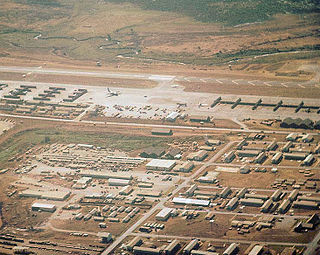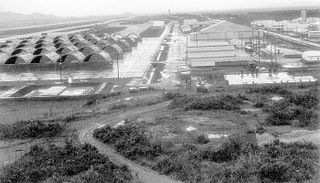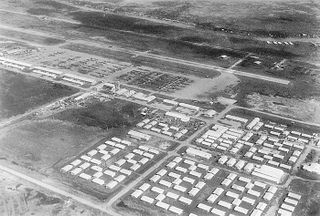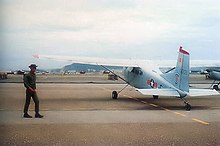
The Douglas AC-47 Spooky was the first in a series of fixed-wing gunships developed by the United States Air Force during the Vietnam War. It was designed to provide more firepower than light and medium ground-attack aircraft in certain situations when ground forces called for close air support.

The Fairchild AC-119G Shadow and AC-119K Stinger were twin-engine piston-powered gunships developed by the United States during the Vietnam War. They replaced the Douglas AC-47 Spooky and operated alongside the early versions of the AC-130 Spectre gunship.

The 14th Flying Training Wing is a wing of the United States Air Force based out of Columbus Air Force Base, Mississippi.

Bien Hoa Air Base is a Vietnam People's Air Force (VPAF) military airfield located in South-Central southern Vietnam about 25 km (16 mi) from Ho Chi Minh City, across the Dong Nai river in the northern ward of Tân Phong, and within the city of Biên Hòa within Đồng Nai Province. The boomburb city is densely populated and rings the base, despite significant levels of agent orange toxins simply left there for decades. The base is scheduled to begin cleanup by 2019.

Pleiku Air Base is a former air force base in Vietnam. It was established by the Republic of Vietnam Air Force (RVNAF) in 1962 at an undeveloped airstrip, and was used by the United States Air Force during the Vietnam War in the II Corps Tactical Zone of South Vietnam. It was captured by the People's Army of Vietnam (PAVN) in March 1975 and was abandoned for many years. Today, the facility has just redeveloped as Pleiku Airport。

Phan Rang Air Base is a Vietnam People's Air Force (VPAF) (Khong Quan Nhan Dan Viet Nam) military airfield in Vietnam. It is located 5.2 miles north-northwest of Phan Rang – Tháp Chàm in Ninh Thuận Province.

Tan Son Nhut Air Base (1955–1975) was a Republic of Vietnam Air Force (RVNAF) facility. It was located near the city of Saigon in southern Vietnam. The United States used it as a major base during the Vietnam War (1959–1975), stationing Army, Air Force, Navy, and Marine units there. Following the Fall of Saigon, it was taken over as a Vietnam People's Air Force (VPAF) facility and remains in use today.

The South Vietnam Air Force, officially the Republic of Vietnam Air Force, was the aerial branch of the Republic of Vietnam Military Forces, the official military of the Republic of Vietnam from 1955 to 1975.

Operation Sure Win 202 was a 1964 Army of the Republic of Vietnam (ARVN) operation carried out with US support. ARVN commandos were transported by U.S. helicopters behind entrenched Viet Cong (VC) positions, attacking them with shoulder fired rockets and flame throwers. Sniper teams then tracked the fleeing rebels and engaged them.

Da Nang Air Base (1930s–1975) was a French Air Force and later Republic of Vietnam Air Force (RVNAF) facility located in the city of Da Nang, Vietnam. During the Vietnam War (1959–1975), it was a major base with United States Army, United States Air Force (USAF), and United States Marine Corps (USMC) units stationed there. Air Vietnam also used the facility from 1951 to 1975 for civilian domestic and international flights within Southeast Asia.

Farm Gate was the code name for an American air force mission operating in Vietnam before the overt US entry into the Vietnam War.

The 6th Special Operations Squadron is part of the 27th Special Operations Wing at Cannon Air Force Base, New Mexico. The squadron operates MC-130J Commando II aircraft in support of special operations. The 6th SOS specializes in the use of night vision goggles and formation tactics to refuel large helicopter and tilt-rotor formations.

The 14th Weapons Squadron is a United States Air Force unit. It is assigned to the USAF Weapons School, stationed at Hurlburt Field, Florida.

The 333d Special Operations Wing is an inactive United States Air Force unit. It was active from July 1968 through March 1970 at Pleiku Air Base, South Vietnam. In 1985, the wing was consolidated with the 333d Bombardment Group as the 333d Special Operations Wing.

The Bombing of Tan Son Nhut Air Base occurred on April 28, 1975, just two days before the Fall of Saigon. The bombing operation was carried out by the Vietnam People's Air Force (VPAF) Quyet Thang Squadron, using captured Republic of Vietnam Air Force (RVNAF) A-37 Dragonfly aircraft flown by VPAF pilots and RVNAF defectors led by Nguyen Thanh Trung who had bombed the Presidential Palace in Saigon on 8 April 1975.

The 930th Operations Group is an inactive United States Air Force Reserve unit. It was last active with the 434th Wing, based at Grissom Air Reserve Base, Indiana. It was inactivated on 1 October 1994.

Phù Cát Air Base (1966–1975) was a United States Air Force (USAF) and Republic of Vietnam Air Force (RVNAF) facility used during the Vietnam War (1959–1975). It is located north of the city of Qui Nhơn in southern Vietnam.

Binh Thuy Air Base was a United States Air Force (USAF), United States Navy, Republic of Vietnam Air Force (RVNAF) and Vietnam People's Air Force (VPAF) (Khong Quan Nhan Dan Viet Nam) military airfield used during the Vietnam War. It is located 7 km northwest of Cần Thơ in the Mekong Delta.

Căn cứ không quân Tuy Hòa is a former air force base in Vietnam, being closed in 1970. It was built by the United States in 1966 and was used by the United States Air Force (USAF) during the Vietnam War in the II Corps Tactical Zone of South Vietnam. It was captured by the People's Army of Vietnam in April 1975 and was abandoned for several decades. Today, the site has been redeveloped as Cảng Hàng Không Tuy Hòa

Vung Tau Air Base (1955–1975) was a Republic of Vietnam Air Force (RVNAF) facility. It was located near the city of Vũng Tàu in southern Vietnam. The United States used it as a base during the Vietnam War (1959–1975), stationing Army, Air Force and Navy units there. It was also the main base supporting Australian operations in the war and Australian Army and Royal Australian Air Force units were based there. Following the Fall of Saigon it reverted to a civil airport which remains in use today.


























